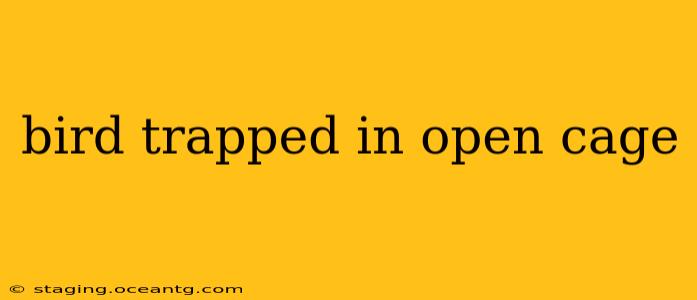Finding a bird trapped in an open cage is a distressing situation, requiring a calm and careful approach. Whether it's a pet bird that's escaped or a wild bird that's wandered in, understanding how to help safely and humanely is crucial. This guide will walk you through the steps to take, answering common questions along the way.
Why is My Bird Trapped in Its Open Cage?
This seemingly paradoxical situation often stems from a bird's innate behaviors and anxieties. While cages are intended to provide security, a bird might perceive its open cage as a temporary, unfamiliar territory. Fear, disorientation, or even simple curiosity can prevent it from readily returning to the perceived safety of its cage. The size and type of cage also play a role. Smaller cages offer fewer options for escape and retreat, making a bird more likely to stay put even when the door is open. Larger cages might cause confusion if a bird feels overwhelmed by its surroundings.
What Should I Do If I Find a Wild Bird Trapped in a Cage?
The approach with a wild bird is different than with a pet. Never attempt to handle a wild bird directly. Their unpredictable behavior can lead to injury for both you and the bird.
- Assess the situation: Note the bird's species, its apparent health, and the type of cage. Is it injured? Does it appear distressed?
- Provide distance and quiet: Minimize your presence and noise around the cage to prevent further stress.
- Contact wildlife rehabilitation: Your local wildlife rehabilitation center or animal control will have the expertise to safely retrieve and care for the bird. They can provide specific instructions depending on the bird's species and condition. Do not attempt to release it yourself unless explicitly instructed by a wildlife professional.
- If the bird is injured: Seek immediate professional assistance. An injured bird requires specialized care.
How Do I Get My Pet Bird Back in Its Cage?
Getting a pet bird back into its cage often involves patience and understanding of their behavior.
- Create a comfortable environment: Reduce noise and distractions, and ensure the cage is clean and appealing. Offer fresh food and water.
- Use positive reinforcement: Try gently coaxing your bird towards the cage with its favorite treats or toys. Avoid chasing or forcing it.
- Offer a perch or familiar object: Place a favorite perch near the cage entrance to encourage your bird to approach.
- Use a darkened room: In some cases, lowering the room's light levels can encourage a bird to enter its cage, as it seeks shelter.
- Seek veterinary help: If your bird remains outside the cage for an extended period, or shows signs of distress, consult an avian veterinarian immediately.
What If My Bird Is Afraid to Go Back in Its Cage?
Fear is a common reason why a bird may hesitate to re-enter its cage. It might be feeling unsafe, stressed, or simply disoriented.
- Identify the cause of fear: Is there something frightening in the room, a new object, or a change in its environment? Remove the fear-inducing factor if possible.
- Create a safe space: Gradually help your bird regain trust by offering quiet interaction and familiar objects within its cage. Cover part of the cage with a towel for a more secure feel.
- Gradual desensitization: Slowly and gently lure your bird toward the cage with treats, avoiding any sudden movements or loud noises.
Is it safe to leave my bird’s cage open overnight?
Leaving a bird's cage open overnight is generally not recommended, especially for smaller or less-experienced birds. While some well-trained birds can be trusted, the risk of injury or escape remains. The unpredictability of nocturnal behavior makes it safer to ensure the bird has a secure, closed cage overnight.
How can I prevent my bird from escaping in the future?
Prevention is key. Ensure that your cage is secure and appropriately sized for your bird's species and temperament. Regularly check the latches and ensure they are properly fastened. Supervision is crucial, particularly during periods when the cage is open. Training your bird to return to its cage on command can be beneficial.
By understanding the underlying causes of a bird being trapped in an open cage and taking a calm, patient approach, you can help ensure its safety and well-being. Remember to always prioritize the bird's safety and well-being, and seek professional assistance when needed.
